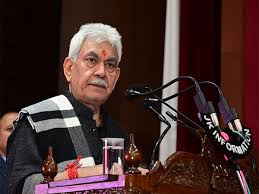Although the challenge of militancy in Jammu may be similar to that faced by the Kashmir Valley, the region is demographically and geographically different. Jammu is a Hindu-majority area and is hillier than the Valley, providing militants with ample hiding spaces. A report by Riyaz Wani

As militant attacks continue to rock the Jammu division of Jammu and Kashmir, the UT government has decided to adopt the Kashmir model of counter-insurgency in Jammu as well.
“We will not allow revival of terrorism in Jammu at any cost and adopt the Kashmir model to wipe out terrorism in Jammu. The way security forces crushed terrorism in Kashmir, a similar strategy will be adopted in Jammu as well,” J&K Lieutenant Governor Manoj Sinha said at an event in Srinagar on July 20. “Today all terror outfits in Kashmir are headless.”
On the same day, Sinha and the Army Chief, General Upendra Dwivedi held two separate joint security review meetings in Jammu to introduce a new counter-terrorism strategy to tackle renewed militancy in the union territory.
Recurrent militant attacks and the attendant loss of lives of security personnel in the Jammu region have created a challenging situation for both the UT and the union government. The new strategy aims to address operational flaws, intensify counter-terrorist operations, and track down hiding militants with active support from locals. But it is likely to take longer before the situation gets better. Although, the local militancy has, to a large extent, been reigned in, the influx of foreigners, especially in Jammu, has thrown the UT into fresh turmoil.
The rise of militancy in twin districts of Rajouri and Poonch in Jammu division, and which is largely led by foreign militants attests to this fact. More than a decade ago, the twin districts were declared free of militancy by the government. However, since October 2021, the region has witnessed an incremental surge in militant attacks. Although an uneasy calm prevailed in Jammu in 2022, this year the region has once again become a hotspot for militants. The dense forests of the region have made it difficult for security forces to trace them.
The situation has been made even more difficult by the fact that the forest area where the militants are hiding extends to the districts in South Kashmir, which have been a stronghold of militancy in recent years.
LG Sinha said that the government is working on a plan to replicate the counter-insurgency strategy adopted in Kashmir Valley to curb the rising violence in Jammu, a statement he had also made last year. This includes identification and arrest of over-ground supporters of militants, proactive counter-insurgency operations, deployment of police, Army, Central Armed Police Force (CAPF) and night patrolling and area domination, which are believed to have helped check infiltration to a large extent in the Kashmir region.
Will the model succeed in Jammu? It is still early days to gauge its efficacy. Although the challenge of militancy in Jammu may be the same faced by the Kashmir Valley, the region is demographically and geographically different from the valley. Jammu is a Hindu majority area and geographically it is more hilly than the Valley, giving militants plenty of hiding space.
There are other important distinctions: Militants in Kashmir have largely been local while those in Jammu are understood to be battle-hardened foreigners with sophisticated weapons.
Since 2021, Jammu has experienced 33 militant-related attacks, according to official data. In 2024 alone, the region witnessed eight attacks, resulting in the deaths of 11 soldiers and injuries to 18 others. Civilian fatalities in Jammu for the first half of this year total 12, matching the number for all of 2023. These attacks took place in Rajouri, Poonch, Doda, Kathua, Udhampur, Reasi, and other areas within the Jammu division. Militants, on the other hand, have suffered lesser fatalities, at least in Jammu region. After every attack they flee deep into forests, making it difficult for the security forces to trace them. They reappear only to stage another attack before escaping back into the woods again.
This is unlike Kashmir where local militants mostly stay in residential areas and the intelligence network is quick to track them down and kill them, without security personnel themselves suffering any losses. Besides, the local nature of militancy ensures that the social support network of militants can be easily reached and targeted. This is not generally the case with foreigners. They maintain a limited contact with the local population. Also, they avoid staying in houses. So, they are not vulnerable in the same way, the militants in Kashmir are. Also, as against people in the Valley who are considered sympathetic to the cause of militants, those in Jammu have generally been supportive of the Army. Taking harsh action against them could backfire on the anti-militancy operations in the region. It could alienate people making their cooperation in the anti-militancy operations as much difficult.
Kashmir model of fighting militancy can’t therefore be easily replicated in Jammu division as announced by the LG Sinha.
True, in the past, the Army has successfully countered militancy of similar nature in Jammu and which could then boast of some local support. In 2003, Operation Sarp Vinash (Snake Destroyer) was launched by the Army to eliminate militants who had established bases in the Hilkaka Poonch-Surankote area of the Pir Panjal range in Jammu and Kashmir during April–May 2003. During this operation, involving seven battalions, 64 militants affiliated with various jihadist outfits were killed. The system of hideouts discovered during this operation was the largest ever recorded in the history of insurgency in Jammu and Kashmir.
Would the Army go for a similar kind of operation in Jammu forests again? It looks likely. However, several smaller operations over the last three years have not yielded the desired result. Now the Army is launching “Operation All Out” modeled after the one conducted in Kashmir in 2017, where security forces launched one to combat a surge in militant violence following the encounter and killing of Hizbul Mujahideen commander Burhan Wani on July 8, 2016.
Over 3,500 security personnel, including 500 elite para commandos, will be deployed, particularly in the border districts of Poonch, Rajouri, Kathua, Doda, Udhampur, and Reasi. The aim is to tighten the siege and prevent militants from escaping. It is a large forest area between Kashmir and Jammu. Would one all-out operation do the job? Only time will tell.
The LG Sinha on July 24 said the situation in the Union Territory “will be back to normal within a few months.”
“Those who cannot digest the peaceful atmosphere here, they should be ready for their end,” Sinha told reporters in Srinagar. “People here have also given a befitting response to them before. The situation demands so.”
The coming weeks and months will be crucial as to the direction of the situation. Much will depend on the success or otherwise of the fresh Operation All Out.













